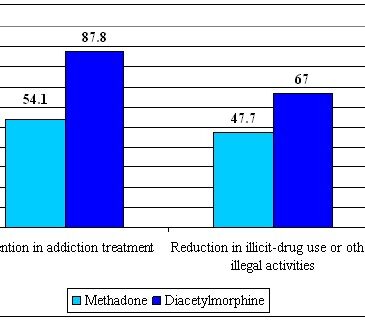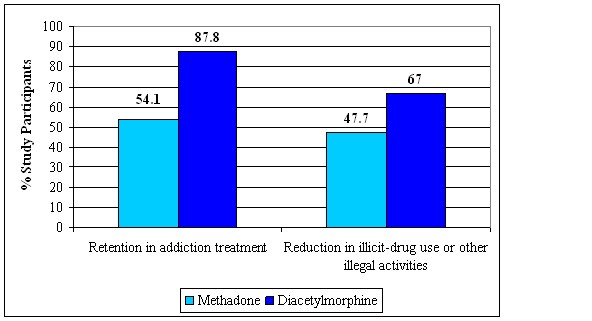Opioid abuse affects more than 1 million North Americans and is a serious public health concern contributing to ill health and fatal overdose (United Nations Office on Drugs and Crime, 2008). Although maintenance treatment with oral methadone is standard for opioid dependence, some opioid-dependent individuals do not respond well, have difficulty maintaining treatment, and/or continue to use illicit opioids while receiving methadone. This week’s STASH reviews the first North American randomized controlled trial of diacetylmorphine, the active component in heroin, versus methadone treatment for opioid dependence in individuals for whom standard treatments have been unsuccessful (Oviedo-Joekes et al., 2009).
Methods
-
- Researchers enrolled 251 opioid users in Montreal, Quebec and Vancouver, British Columbia, into an open-label, randomized controlled trial. Participants all had injected opioids daily for the past year and had at least two previous treatment attempts including one attempt with methadone treatment.
- Participants were randomized into three1 groups for the 12-month study period.
-
-
- methadone (N=111): taken orally and dispensed once daily at clinic sites.
- diacetylmorphine (N=115): self-administered by injection up to three times daily by participants under medical supervision at study clinic sites.
- The primary outcomes of interest, assessed at 3, 6, 9, and 12 months were:
-
-
- Retention in treatment or drug-free status outside of the study context.
- Reduction in illicit drug use and/or other illegal activity assessed by the European Addiction Severity Index.
Results
- Figure 1 shows that treatment retention for participants receiving injectable diacetylmorphine was 87.8% compared to 51.4% of participants receiving oral methadone at 12-month follow-up, a significant difference (p < .0001).
- Figure 1 also shows that rates of illicit drug use and/or other illegal activities were reduced by 67.0% in the diacetylmorphine treatment group compared to 47.7% in the methadone treatment group (p < .01).
- The mean number of days of illicit heroin use per month was reduced from 26.6 to 5.3 in the diacetylmorphine group compared to a reduction from 27.4 to 12.0 days per month in the methadone treatment group (p < 0.001).
Figure. Primary Outcomes at 12 Months (adapted from Oviedo-Joekes et al., 2009). Click image to enlarge.
Limitations
- The study relies on self-report data of illicit opioid use.
- Given the nature of the treatments under investigation, it is not possible to perform a double-blind study.
- Authors fail to acknowledge or control for the possible confounding of treatment outcome due to route of administration (i.e., injection use versus oral ingestion), social setting within which people use these drugs, with psychoactive effects of the drug.
Conclusion
This study shows that individuals treated for opioid dependence with injectable diacetylmorphine were more likely to remain in treatment and were less likely to engage in illicit drug use or other criminal behaviors compared to those treated with oral methadone. The study authors conclude that for the subgroup of opioid-dependent individuals for which traditional (i.e., methadone) treatment options are not successful, clinically supervised treatment with diacetylmorphine appears to be a safe and effective treatment option. This interpretation must be tempered, however, because the researchers failed to account for the potential confounding effect of route of administration (i.e., oral vs. injected) on the study outcomes. It is likely that injection heroin users would prefer injection to another treatment (i.e., oral methadone) that requires significant behavioral change and places them on a different physiological and therefore psychosocial schedule. Perhaps diacetylmorphine administration is more appropriately understood as a harm-reduction strategy similar to needle exchange programs. Further research is needed to assess the impact of diacetylmorphine administration on the lives of opioid dependent individuals.
-Erica Marshall
What do you think? Please use the comment link below to provide feedback on this article.
References
Haasen, C., Verthein, U., Degkwitz, P., Berger, J., Krausz, M., & Naber, D. (2007). Heroin-assisted treatment for opioid dependence: randomised controlled trial. Br J Psychiatry, 191, 55-62.
Oviedo-Joekes, E., Brissette, S., Marsh, D. C., Lauzon, P., Guh, D., Anis, A., et al. (2009). Diacetylmorphine versus methadone for the treatment of opioid addiction. N Engl J Med, 361(8), 777-786.
United Nations Office on Drugs and Crime. (2008). World drug report. Vienna.
van den Brink, W., Hendriks, V. M., Blanken, P., Koeter, M. W., van Zwieten, B. J., & van Ree, J. M. (2003). Medical prescription of heroin to treatment resistant heroin addicts: two randomised controlled trials. Bmj, 327(7410), 310.
________________
[1] Twenty-five study participants were assigned to receive a treatment option not addressed in this review.





